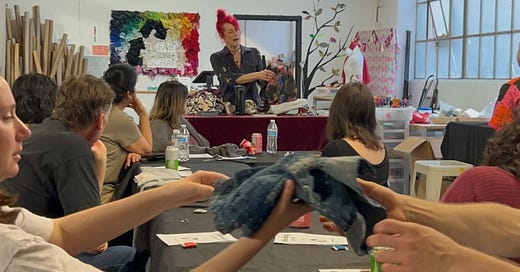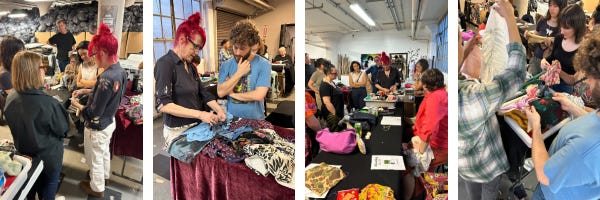
Last night an excited group walked into FABSCRAP to dive deeper into mending!
Led by Kate Sekules, our workshop explored the visible mending technique: Layered Patching!
Below is a recap, including:
History of Mending
Social, Emotional, Environmental, & Political Impacts
Layered Patching Techniques
Why not call it Boro or Sashiko?
+ resources from the workshop & community members.
***FABSCRAP Workshop FOMO is real! Don’t miss the next one on DARNING!
Darning is a simple mending technique used to repair holes in fabric by weaving new threads into the worn area, making your clothes, blankets, or accessories last longer!
If you don’t know already - the theme for this cluster of events is “Sewing Circles and System Change”
Mending and community organizing have this chicken-and-egg relationship—each feeds into the other, making it hard to tell which truly comes first. Historically, mending was never just about patching up a hole in a sock; it was about sustaining people, relationships, the planet, and collective survival. Think about quilting bees in 19th-century America—women came together not just to repair fabric but to weave social bonds, share knowledge, and subtly organize around issues like suffrage and abolition. Similarly, during the AIDS crisis of the 1970s and 80s, activists and loved ones stitched together the AIDS Memorial Quilt—not just as an act of remembrance, but as a form of organizing, demanding visibility and action in the face of government neglect. Mending, as an act, keeps communities intact, and strong communities, in turn, make space for the kind of resourcefulness that mending requires. It’s a cycle—like community organizing itself—where every stitch is both practical and deeply political.
Mending, handcrafts, sewing, etc. are undervalued in society. Now, I could write an entire post about this but just think about it in your own life.
How did you learn to mend?
More and more it’s not from school or formal lessons, you probably learned from your mother, aunt, or grandmother. I’m interested in the connection between mending being deemed as “women's work” and its elimination from school curriculums. Just as mending is undervalued, so is women’s work.
See:
Keep reading with a 7-day free trial
Subscribe to Better Together Substack to keep reading this post and get 7 days of free access to the full post archives.







